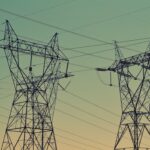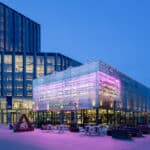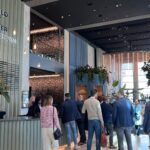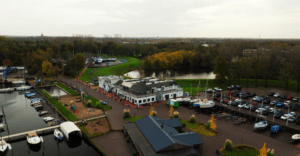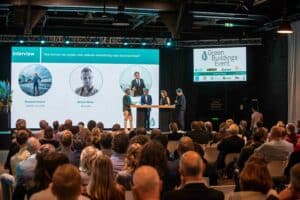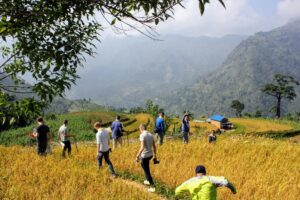
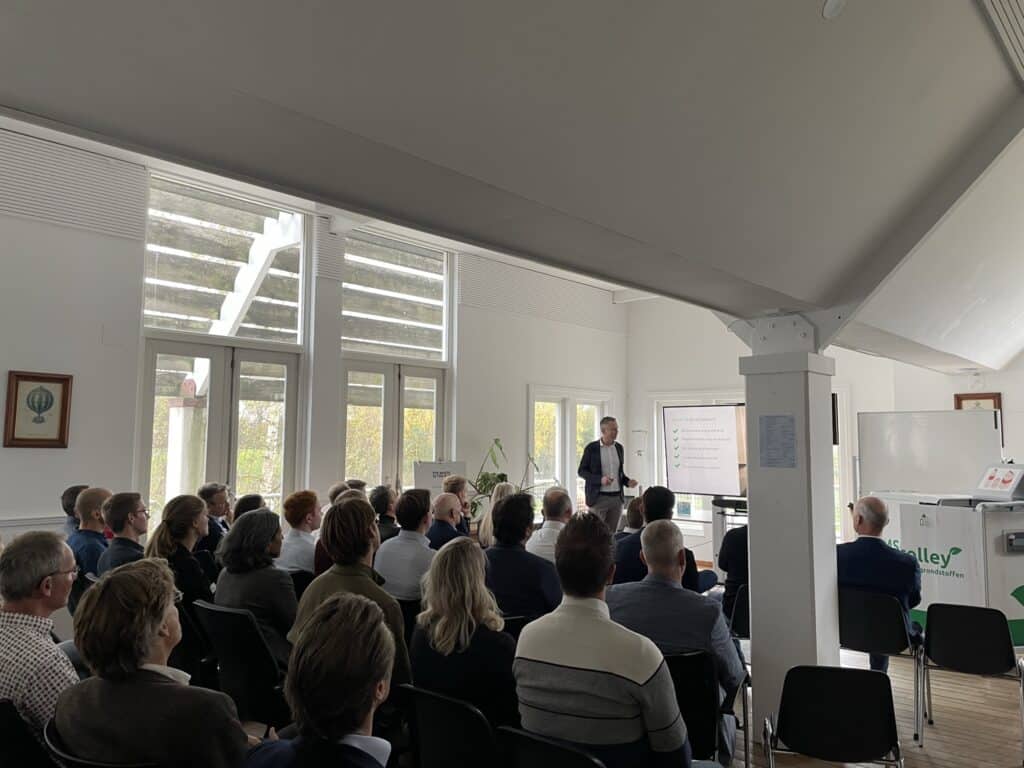
21st CFP Innovation Day: from induction boilers to a development project in Nepal (Hall 1)
We are surrounded by ambitious sustainability goals. Energy transition, circularity, biodiversity: to fulfil them all, one element is indispensable. The importance of innovation was again evident at the CFP Innovation Day on 9 November in Naarden. An afternoon of pitches from entrepreneurs making a difference and the opportunity to talk to eager buyers right away.
In this article, you can read more about the pitches from IBIS Power, Milieu Service Nederland, Rhino, Unica Foundation, RABLE, Fagerhult, TI Green and Eevery. Curious about the other eight pitches? Then read on here.
Innovation can make the difference in your organisational growth and accelerate sustainability. Bram Adema illustrated that with his kick-off. Standing on a beer crate, he looked back at the history of CFP Green Buildings and showed what innovation looked like for his organisation: “From the start of CFP, we were seeking how to make the largest possible impact in sustainability. We focused on understanding and optimising building performance with the Green Buildings Tool. And: ensuring performance. In 2012, we took a close look at several thousand buildings. But we wanted to be ten times bigger. And even such a multiplication was insufficient to make the impact we envisaged.”
Innovating internationally
There was a great opportunity to empower everyone in the Netherlands to become more sustainable. “We got the banking sector on board and the Green Buildings Tool appeared in 2015 at PROVADA attracting great interest. As we stepped up a gear in the Netherlands, the international market could obviously not be left behind. One of the launching customers from an international perspective was Cushman & Wakefield. Our services are now being deployed in 26 countries.” According to Bram, the growth would never have happened without innovation: “We continued to innovate and expand our thematic focus. We now offer tools to boost biodiversity, circularity and more. And we are far from finished.”
Major challenges
After this look at the history of CFP Green Buildings, it was time to take a closer look at the innovations. A veritable Dragons Den in two rooms: pitchers who quickly highlighted their innovations to a mixed audience, followed by various critical questions. Jan Gijsbers of IBIS Power kicked off the event, focusing on the sustainability challenges: “We are facing major challenges. For example, we want a natural gas-free built environment, with no harmful greenhouse gas emissions. To achieve that, we need to make things more sustainable, but that is not easy to implement for all buildings. PowerNEST provides a combination of solar and wind energy: a nest of solar panels containing a wind turbine. Jan: “We optimise the generation process in all sorts of smart ways. By doing so, we achieve ten times more generation of renewable energy compared with just installing solar panels on a flat roof. This approach ensures that you use more than 100 per cent of the entire roof area.”
Real-time insight
Sustainability challenges around greenhouse gas reduction and renewable energy generation are an important part of the Environmental, Social and Goverance (ESG) criteria. By mapping these out, you will know as a company where you stand on sustainability and discover what opportunities you are missing. Mark Schrage of Milieu Service Nederland responded to that need with the MSG trolley. This trolley allows cleaners to weigh waste according to type and space. This, he says, provides valuable insights, more sustainable waste management and a fair distribution of costs per tenant. “You obtain real-timeinsight into waste, per tenant and per waste stream. This allows for a fair distribution of costs and accelerated sustainability of buildings. The polluter pays. In buildings housing multiple tenants, this ensures transparency and creates behavioural change.”
Xander van Baarsen of Rhino also showed solution approaches concerning the topic of ESG. Admittedly a different type of innovation: a data aggregation platform, which maps consumption data for electricity, gas and water for commercial properties. “We give you those insights at building level. And at portfolio level, you can count on standardisation and centralisation of data. This helps in reporting, especially with the ‘E’ of ESG. We provide a data platform that delivers information on gas, water and electricity in real time. Both for main and sub-meters, which is important for multi-tenant buildings. This allows you to gain knowledge and solve data gaps for a wide variety of property types. On a dashboard, you can accurately read where and which facilities are being used and create reports and analysis for improvements.”
Social innovation
Edwin Koers of Unica Foundation took a different tack and focused on social innovation during a technical development project in Nepal: “Here it’s not so much about making buildings and processes more sustainable but about helping people. We help them create better living conditions, with clean drinking water, training courses, irrigation and improved cookers.” The approach focuses on a participatory model involving local people. CFP also participates. Seventy projects have already been realised and nine are currently ongoing. “We ensure, for instance, that the population can set up agriculture activities independently, such as growing peppers and mushrooms. We also see that by reviving a region in which we carry out projects, tourism is boosted. More and more partners are committing to these objectives and linking the project to their CSRD goals.”
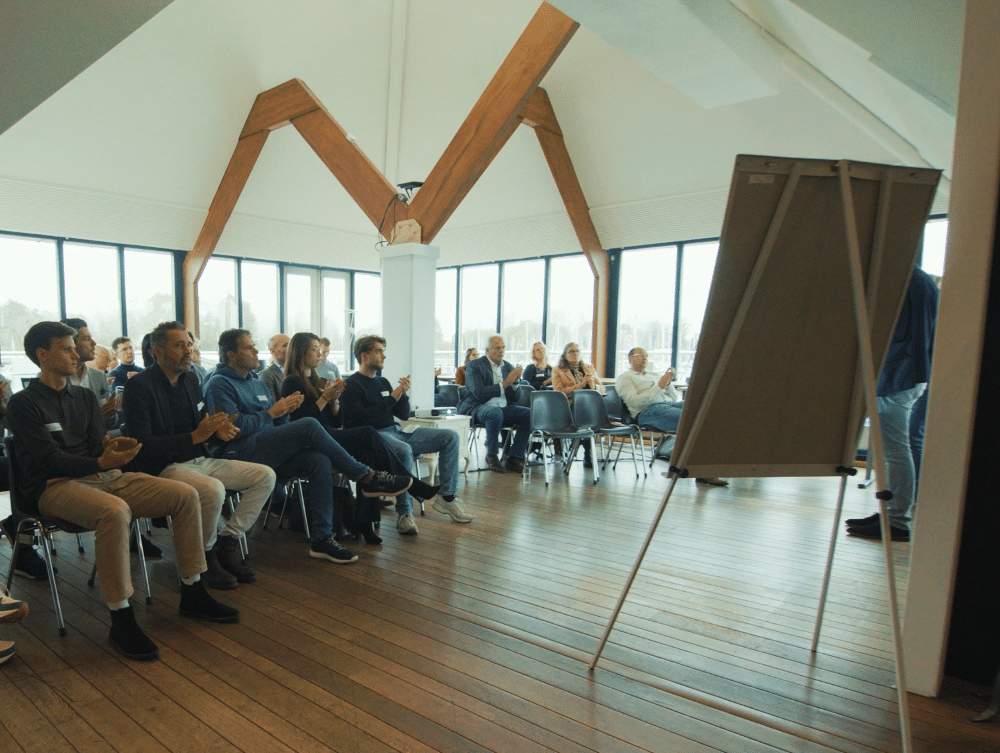
Weak roofs: obstacle?
After the networking break with plenty of new connections, it was up to Erik Valks of RABLE to comment on the opportunities for renewable energy generation. He referred to a report by the Netherlands Enterprise Agency (RVO): ‘More than 52% of roofs are too weak for solar installations’. A major drawback, as renewable energy is badly needed for electrification and application of heat pumps in buildings, for example. Valks presented a solution that will ensure in the short term that these roofs can still be used for renewable energy generation: “We discovered a bottleneck that developers and installers often face when they want to fit solar panels. More than half the roofs are too weak and we came up with a system consisting of a mounting structure over the horizontal axis and a steel cable along the length. We can increase the potential for rooftop renewable energy generation from 14 to 29 terawatts. That’s what we’re aiming for.”
Minimising environmental impact
Gerard-Jan van Bruinessen of Fagerhult stepped up and highlighted the opportunities from his organisation for circular construction. “We know we need to focus on minimising the impact we make with materials in the production and use phase. We are responding by revamping one of the most popular luminaires with a fresh housing and packaging method.” Multilume Re:Think is made entirely of organic material: Solid Board. “We no longer need steel and coating can be omitted. We also no longer need polystyrene and corner protectors nor plastic protection material. This results in less waste and less negative impact on the environment. The environmental impact has been reduced 80 per cent.”
From boiler to induction boiler
After this novelty in materials and circularity, it was time to return to solutions for the energy transition. An installation innovation was presented by Cas Goenee of TI Green: “We developed a boiler based on induction technology. We convert energy directly into usable heat through the induction unit. One of the advantages of this technology is that the core heats up very quickly.” This makes it possible to use heating and hot water within seconds. This makes the induction boiler an alternative to a heat pump. “Except that compared with that technology, no large-scale conversion is required and no outdoor unit is installed. The installation takes half a day. So our promise is that with our technology, you can become gas-free within half a day. The technology can deliver heat to existing radiators, for example at 65 degrees.”
Making ESG performance transparent
The final pitcher had now climbed onto the stage in the ‘t Wiel hall: Michiel Slinkert of Eevery. “We have a platform that supports businesses in sustainability projects. We want to provide a practical and approachable solution to make your ESG performance transparent. A baseline measurement provides insight into where you are now and how you can work towards complying with international legislation such as the Corporate Sustainability Reporting Directive (CSRD) and the EU Taxonomy.” All kinds of data are collected to indicate how far you are from specific targets that correspond to the standards to be achieved. “In this case: less is more. It’s not about the amount of information, but what you do with it. Above all, our advice is to be visible and make your journey towards a future-proof environment tangible.”
Moment suprême
After the voting rounds for the pitches, it was high time to gather in the plenary hall for the moment suprême: the announcement of the CFP Innovation Day winners. Bram Adema announced who had received the most votes: Fagerhult, biocompact, RABLE and Oyster Heaven. Two names that the participants in the ‘t Wiel hall had not yet heard about. Curious about the other eight pitchers? Check them out here.
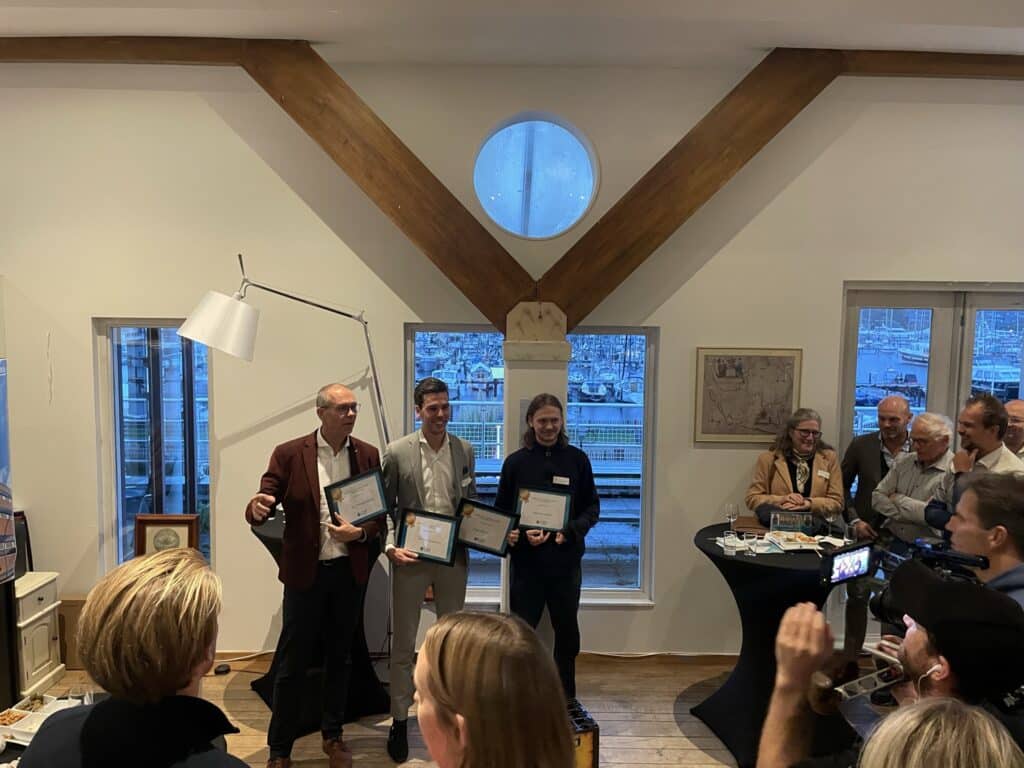
Taking sustainability steps
Before the CFP Innovation Day came to an end, Bram shed some light on the CFP Green Buildings Event coming up in 2024. “Please note 11 April in your diary, because then it will be happening again. You can count on 50 building owners showing what they managed to achieve in terms of sustainability, and the winners of this CFP Innovation Day will also be appearing. I’m looking forward to it. We will meet again on 11 April for a big dose of inspiration!”
